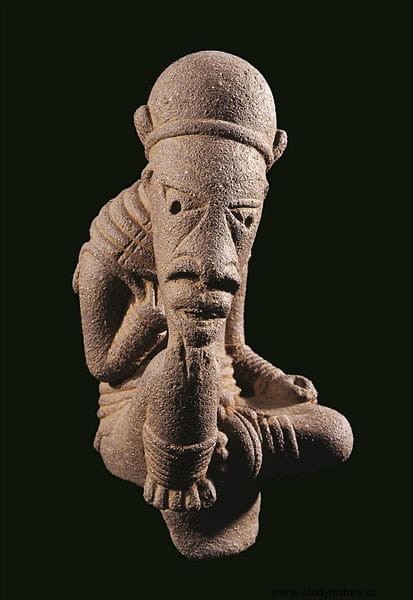At this point it may seem strange that there are still practically unknown civilizations, of which we barely know the place they inhabited and the approximate dates of their appearance and disappearance. If the level of development of that civilization is more advanced than it should be , according to the temporary records and their location, things get interesting.
The Nigerian civilization of Nok it does all that, with a quirky addition:they were making life-size terracotta figurines at least a couple of centuries before the Chinese created their famous Xian Warriors. It was precisely thanks to the fragments of these terracottas that their existence was discovered in 1928, although it would still be many years before anyone realized how special those figures were.

The first fragments appeared in a mine in the town of Nok in Nigeria. The miners found small human and animal heads, and a terracotta foot, which were stored, without much concern, in the museum of the city of Jos. In 1932 another 11 figures appeared near Sokoto, which went just as unnoticed.
It would not be until 1943 when a good handful of new terracottas were found in another Nok mine, with the luck that at that time the civil administrator of the mining company was an archaeologist named Bernard Fagg, who immediately understood what they meant.

Fagg set about buying as many terracottas as he could from locals who had previously found them and kept them in their homes as ornaments. He also instructed his miners to carefully collect all new finds. He soon had in his possession more than 200 pieces.
When he carried out radiocarbon analyzes of the terracottas and soil from the places where they had appeared, he could not believe what he found. They dated back to 500 BC ., something impossible given that the type of society that could have produced those works was supposed not to have existed in West Africa until much later.
That would not be the only surprise. At a site near the town of Taruga he found up to 13 ancient iron furnaces around which terracottas also appeared, which Fagg interpreted as offerings. Radiocarbon dating gave a date of 280 B.C. for furnaces, making them the earliest evidence of iron forging in sub-Saharan Africa.

What Fagg had discovered provided the basis for recognition of an advanced civilization:fine art, organized religious beliefs, and metalworking.
Since then, archaeological excavations and researchers have continued to delve into the Nok civilization, so that today it is assumed that its birth occurred around 1000 BC, and its disappearance occurred around 300 AD. without knowing anything about the circumstances of both.
There are those who have wanted to see descendants of the Egyptians in the Nok, which would explain the degree of maturity of their culture and their art, but there is no proof of this and this theory is currently highly discredited. The researchers believe that they could have been North African peoples that, about 2,500 years ago, they were forced by drought to migrate south, bringing with them the farming techniques, livestock, and metallurgy that would start the Iron Age in Africa. But aside from this, little or nothing else is known about the Nok.
Regarding the terracotta figures practically none have been preserved intact, almost all are incomplete and are therefore best known only for their stylized heads and hairstyles. Some heads that the Nok represented with elongated features that led some to consider them alien works of art. Nothing is further from reality. Most possibly represent ancestors or important members of the community, and would have a funerary or amulet function.

The oldest found are more than 3,000 years old and, curiously, the material with which they were made seems to always come from the same place, whose location is unknown. The largest of all exceed a meter in height, possibly approaching the average height of Nok individuals, and required very sophisticated furnaces for their creation (remember that Fagg found up to 13 furnaces that he identified as metallurgical furnaces).
The creation of these works required a technical skill that makes researchers think that Nok art must have many centuries of tradition before reaching such refinement. However, no signs of this artistic evolution have been found, nor of experimentation, accidents or flaws in the bill, as if the technique had always had the same maturity.
Despite the importance that the Nok civilization or culture has in the context of prehistory and African history, its study is still very limited, and the bibliography barely has a handful of studies, which by the way are usually out of print and whose price It is certainly prohibitive for the average fan. As an example, Bernard Fagg's own book on his discoveries currently fetches 500 euros.
